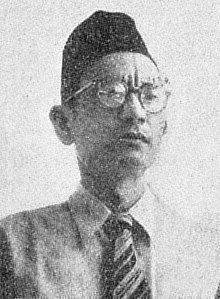Mananti Sitompul | |
|---|---|
 Official portrait, c. 1950 | |
| 5th Minister of Public Works and Housing | |
| In office 21 January 1950 – 6 September 1950 | |
| President | Sukarno |
| Prime Minister | Abdul Halim |
| Preceded by | Herling Laoh |
| Succeeded by | Herman Johannes |
| In office 19 December 1948 – 13 July 1949 | |
| Executive | Sjafruddin Prawiranegara |
| Preceded by | Herling Laoh |
| Succeeded by | Herling Laoh |
| Minister of Health (acting) | |
| In office 19 December 1948 – 14 March 1949 | |
| Executive | Sjafruddin Prawiranegara |
| Preceded by | Johannes Leimena |
| Succeeded by | Soekiman Wirjosandjojo |
| Personal details | |
| Born | Mananti Sitompoel 9 June 1909 Pahae, North Tapanuli, Dutch East Indies |
| Died | 27 February 1980 (aged 70) |
| Nationality | Indonesian |
| Political party | Christian Party (Parkindo) |
| Alma mater | Technische Hoogeschool te Bandoeng (THB) |
| Occupation | |
Mananti Sitompul (EVO: Mananti Sitompoel; 9 June 1909 – 27 February 1980), was a Christian Indonesian politician from North Sumatra. A member of the Indonesian Christian Party (Parkindo), he served in several national cabinets during the Indonesian National Revolution. Born in Pahae, North Tapanuli, he studied at the Technische Hoogeschool te Bandoeng (THB), and graduated as a civil engineer in 1939. Subsequently, he worked at the Waterloopkundig Laboratory and later at the Waterstaatsdienst. During the Japanese occupation, he became the head of the Provinciale Waterstaat of West Java, before he moved to Sukabumi and later Jakarta, to work in the Public works office.
Following the proclamation of independence, he served as the deputy head of the West Java Ministry of Public Works. He moved to Pematangsiantar, and later Bukittinggi, and became the head of the Sumatra Ministry of Public Works. In 1948, following the capture of the capital of Yogyakarta by Dutch forces, he was appointed both Minister of Public Works and Minister of Health, replacing Herling Laoh and Johannes Leimena respectively. He was replaced as health minister by Soekiman Wirjosandjojo, and after the signing of the Roem–Van Roijen Agreement, was replaced as Public Works minister after the restoration of Minister Herling Laoh. He returned to government in 1950, in the Halim Cabinet, and served as Public Works minister again until the dissolution of the cabinet. He died in 1980.